Woodstock, Illinois
Woodstock is a city in (and the county seat of) McHenry County, Illinois, United States. It is located 45 miles northwest of Chicago, making it one of the city's outer-most suburbs.[2] Per the 2020 census, the population was 25,630.[3] The city's historic downtown district and turn-of-the-century town square is anchored by the landmark Woodstock Opera House and the Old McHenry County Courthouse. In 2007 Woodstock was named one of the nation's Dozen Distinctive Destinations by the National Trust for Historic Preservation.[4]
Woodstock | |
|---|---|
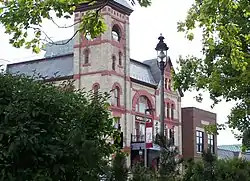 The landmark Woodstock Opera House building in historic downtown Woodstock | |
| Motto(s): "True to Its Past; Confident of Its Future" | |
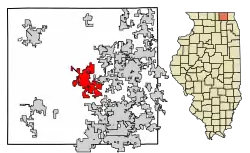 Location of Woodstock in McHenry County, Illinois. | |
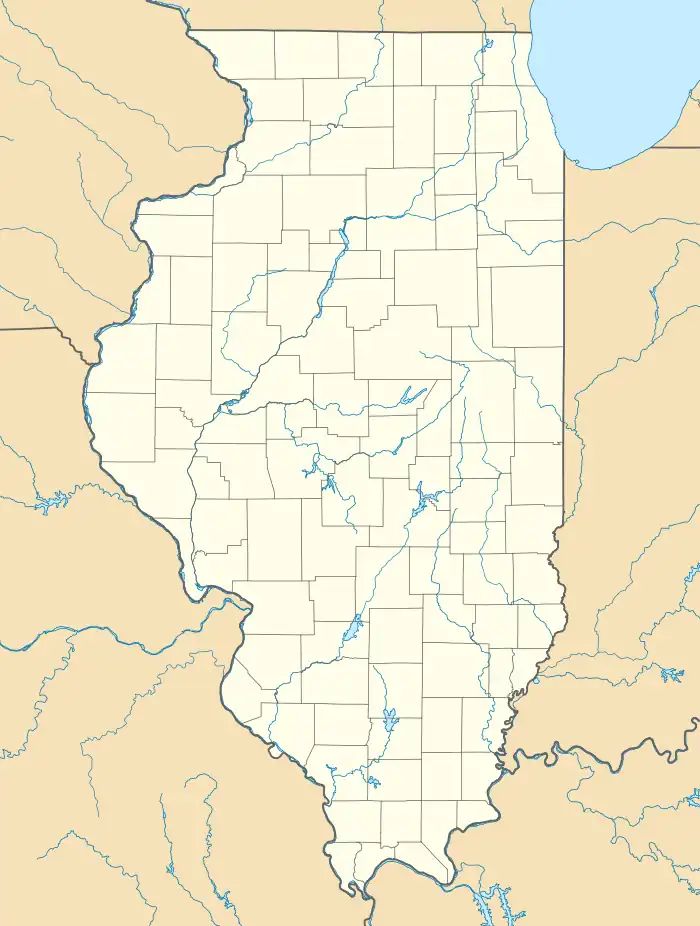 Woodstock  Woodstock | |
| Coordinates: 42°18′53″N 88°26′51″W | |
| Country | United States |
| State | Illinois |
| County | McHenry |
| Townships | Dorr, Greenwood, Hartland, Seneca |
| Founded | 1852 |
| Government | |
| • Mayor | Michael Turner |
| Area | |
| • Total | 13.19 sq mi (34.15 km2) |
| • Land | 13.19 sq mi (34.15 km2) |
| • Water | 0.00 sq mi (0.00 km2) |
| Population (2020) | |
| • Total | 25,630 |
| • Density | 1,943.58/sq mi (750.41/km2) |
| Time zone | UTC-6 (CST) |
| • Summer (DST) | UTC-5 (CDT) |
| ZIP Code(s) | 60098 |
| Area code | 815/779 847 |
| FIPS code | 17-83349 |
| Wikimedia Commons | Woodstock, Illinois |
| Website | www.woodstockil.gov |
History
Early days, Centerville
Woodstock was originally known as Centerville because of its location at the geographic center of McHenry County. It was chosen as the county seat on September 4, 1843. Early settler Alvin Judd developed a plat for the town, which incorporated a two-acre public square, near which a 2-story frame courthouse and jail were constructed the following year by George C. Dean and Daniel Blair.[5]
In 1845, prominent resident Joel Johnson proposed that Centerville be given a more original name, and the town was renamed Woodstock after Johnson's hometown of Woodstock, Vermont. The town was still listed as "Center" on the 1850 Federal Census. In 1852, Woodstock was incorporated as a village with Judd as president. In response to a growing population following the end of the Civil War, Woodstock was incorporated as a city in 1873.[5]
John S. Wheat was elected as Woodstock's first mayor. A vital artery for the growing town was the train line to and from Chicago, which allowed for a substantial industrial presence early in the town's history.[5]
Eugene V. Debs' prison stay
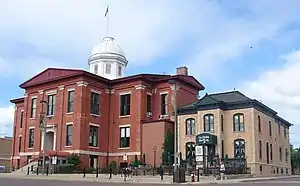
In 1895, Eugene V. Debs served a short federal prison sentence in the Woodstock Jail following the 1894 Pullman labor strike in Chicago. Debs, the former president of the American Railway Union, was held in Woodstock instead of Chicago because federal officials feared that he would be surrounded with too many sympathizers in a Chicago prison and therefore could have still incited further unrest. Debs was instead assigned to a cell in the newly constructed Woodstock Jail, which occupied the lowest floor of the Woodstock Courthouse on the town square.[6]
During his time in the jail, Debs received several influential socialist visitors and encountered the works of Karl Marx. He is said to have considered the Woodstock Jail one of the "greatest school[s]," and passed his time reading and writing many letters from his cell. By the time he was released in November 1895 (to great fanfare and before crowds of onlookers assembled in the Woodstock Square), Debs had become a socialist and a national celebrity.[6] He later ran for the United States Presidency five times between 1900 and 1920 as the candidate for the newly formed Social Democratic Party.[7]
"Typewriter City"
During the early part of the 20th century, Woodstock had become "Typewriter City" and was home to factories of both the Emerson Typewriter Company and the Oliver Typewriter Company. Woodstock workers had built more than half the world's typewriters by 1922.[5] The companies were very much a part of civic life in Woodstock during this time. Both factories had active social clubs, baseball teams that competed against one another, and Emerson had a well-regarded band that played at public events.[8][9]
In 1919, Emerson Typewriter became the Woodstock Typewriter Company. The city grew and flourished with increasing demand for Woodstock typewriters through and after World War II. Initially the company sold typewriters for use in the war effort both domestically and abroad, but after the war's end returning servicemen, now familiar with the Woodstock brand, chose these models for their households. The factory was in use until 1970, and has since been converted into lofts.[8][9]
 Main Street looking north, circa 1910
Main Street looking north, circa 1910 Typewriters in a Woodstock business' window in 2013. Note the name "Woodstock" on some of them.
Typewriters in a Woodstock business' window in 2013. Note the name "Woodstock" on some of them.
Orson Welles and the Todd School for Boys
Woodstock had an important role in the creative development of Orson Welles. In 1926, in the midst of a chaotic upbringing, he enrolled at the Todd School for Boys in Woodstock at age 10. His five-year stay there was his only formal education, and the town and school made an impression on the young Welles. Years later, in 1960, when asked where he thought of as his hometown, he replied "I suppose it's Woodstock, Illinois, if it's anywhere. I went to school there for four years. If I try to think of a home, it's that."[10][11]
At Todd School, the young Welles came under the positive influence and guidance of Roger Hill, a teacher who later became the school's headmaster. Hill provided Welles with an educational environment that supported his creativity, allowing Welles to concentrate on subjects that interested him. Welles performed and staged his first theatrical experiments and productions at Todd. He also performed at the downtown Woodstock Opera House, where the stage — the site of his American debut as a professional theatre director — is now dedicated to him.[12][13]
Welles returned to Woodstock periodically after leaving school. In July 1934 at the age of 19, he coordinated the Todd Theatre Festival, a six-week summer festival at the Woodstock Opera House that featured Hilton Edwards and Micheál MacLiammóir of Dublin's Gate Theatre.[14]: 165 His short film The Hearts of Age was shot on the Todd School campus during the festival.[15][16]
Todd School for Boys closed in 1954. Several original buildings were purchased at auction and reused by Marian Central Catholic High School and Christian Life Services.[17] Welles' former dormitory was demolished in 2010.[18]
Roles in popular media
Planes, Trains and Automobiles, 1987
Several scenes in the 1987 film Planes, Trains, and Automobiles were shot in Woodstock, including the scene in which the protagonists' rental car is towed in front of a building, the old Courthouse.[19] The movie brought Woodstock to the attention of location manager Bob Hudgins, who later recommended the town to Harold Ramis for the filming of Groundhog Day.[20]
Groundhog Day, 1993
Woodstock is perhaps most famous for its role as the location for the 1993 movie Groundhog Day, starring Bill Murray. Although the story is set in Punxsutawney, Pennsylvania, the movie's producers preferred the quintessentially American, but non-specific backdrop of Woodstock Square and its surroundings. Outdoor and street scenes were filmed around the downtown and various side streets, and signs from stores and businesses are visible throughout the movie.[19]
Many notable scenes' locations are commemorated with plaques as part of a walking tour for visitors and enthusiasts.[21] In January 2020, several key actors, including Bill Murray, Brian Doyle-Murray and Stephen Tobolowsky returned to Woodstock to film a Groundhog Day-themed commercial for Jeep. The commercial aired during the 2020 Super Bowl.[22]
Other
Woodstock was the basis for the fictional town of Hawkins Falls in the 1950s television soap opera Hawkins Falls, Population 6200. The city was the site of primary filming for the movie Bored Silly, which was released in 2000.[23] In August 2018, it was reported that filming had begun in and around the Square for the 2019 HBO series Lovecraft Country from producers J. J. Abrams, Jordan Peele, Misha Green and Ben Stephenson.[24] A map of Woodstock can be seen on the splash screen for The Jackbox Party Pack 4 game Civic Doodle where the historic square and Illinois route 47 and 120 are clearly visible.[25]
In September 2021, a second commercial began filming in Woodstock, including the Woodstock Square and the surrounding areas, for Toyota, which began airing on television later that December.[26]
Woodstock was also a primary filming location for the Amazon series Night Sky doubling as the fictional Farnsworth, Illinois.
Local culture
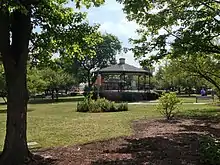
Local newspaper
The Woodstock Independent is the award-winning local paper of record and is delivered weekly to subscribers.[27] Published on Wednesdays, The Independent covers community news, events as well as local government and schools. The Independent also publishes The Torch, a feature-oriented magazine delivered free to all Woodstock residents 8 or 9 times a year.[28]
Music
Woodstock has become an important destination for live music in McHenry County and the region with venues featuring local, national, and international artists.
A number of organizations support and promote live music in Woodstock:
- Liquid Blues
- Jazz on the Square
- Off Square Music
- Opera Woodstock
- RIFF Productions
- Woodstock Folk Festival
- Woodstock City Band
- Potts & Pans Steelband[29]
Religion
Woodstock is home to many Protestant and Catholic churches, a Jewish congregation and The Blue Lotus Buddhist Temple since 2002.
Education
Woodstock's public schools are part of Woodstock Community Unit School District 200, which was formed in 1969.[30] The district operates 1 early learning center (Verda Dierzen), 6 elementary schools (Dean Street, Greenwood, Mary Endres, Olson, Prairiewood and Westwood), two middle schools (Northwood and Creekside) and two high schools (Woodstock High School and Woodstock North High School).[31] The three newest buildings, Prairiewood, Creekside and WNHS, were approved in a March 2006 referendum to address crowding in schools due to the area's growth between the mid-1990s and 2008.[30]
Woodstock is served by private educational institutions: St. Mary Catholic grade school (K-8) is located in town. Students often continue on to Marian Central Catholic High School, also located in Woodstock.
Residents pursuing an associate degree normally do so at McHenry County College in neighboring Crystal Lake. Loyola University Chicago owns and operates a large property on Woodstock's eastern edge as its Retreat and Ecology Campus.[32] Aurora University also operates its Woodstock Center downtown.
Economy
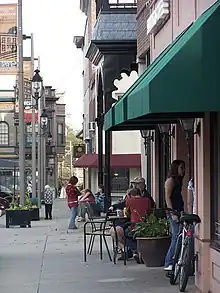
Top employers
According to Woodstock's 2018 Comprehensive Annual Financial Report,[33] the top employers in the city are:
| # | Employer | # of Employees |
|---|---|---|
| 1 | McHenry County | 1,249 |
| 2 | Woodstock Community Unit School District 200 | 1,142 |
| 3 | Northwestern Memorial Hospital | 904 |
| 4 | Catalent | 590 |
| 5 | Charter Dura-Bar | 335 |
| 6 | Claussen Pickle Company | 300 |
| 7 | Walmart | 277 |
| 8 | Berry Plastics | 180 |
| 9 | Other World Computing | 180 |
| 10 | Menards | 140 |
Transportation
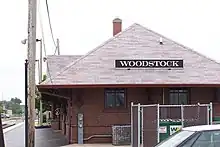
Public transit
Woodstock's railroad station is the penultimate passenger stop on Metra's Union Pacific Northwest Line, which originates from Ogilvie Transportation Center in downtown Chicago and ends in Harvard, Illinois. At Woodstock, Metra offers passengers 14 daily trains to Chicago on weekdays, with 13 returning outbound.[34] Between 400 and 500 passengers use the train daily for travel to Chicago or other suburban communities along the line.[35]
This direct link to the city was historically instrumental in Woodstock's growth as a city, and remains an attractive option for local commuters and residents to reach Chicago. As a result, Woodstock's use of the system is greater than that of nearly half of the Metra system's other outlying stations, many of which serve larger or geographically nearer communities.[36]
Other public ground transportation is limited to Pace bus route 807, which connects downtown Woodstock with downtown McHenry.[37]
Major roads
U.S. Route 14 once took drivers through the heart of downtown Woodstock, but a modern bypass now curves around the city's southwest border. Illinois Route 47 runs through the city in the north–south direction. Illinois Route 120's western terminus is in northwest Woodstock, and continues east past Woodstock's downtown and into rural McHenry County.
Notable people
- Jack Allen, professional baseball infielder for the Syracuse Stars and the Cleveland Blues
- Jessica Biel, actress and model
- Bob Bird, Alaskan pro-life and political activist, first Distinguished Alumnus of Marian Central, graduated in 1969.
- Michael J. Brown, Illinois state representative and businessman
- Bryan Bulaga, football player, University of Iowa and Green Bay Packers
- Rick Fletcher, illustrator and cartoonist with Chicago Tribune; best known for The Old Glory Story and Dick Tracy
- Chester Gould, cartoonist and the creator of the Dick Tracy comic strip
- Nikol Hasler, author, sexual educator, internet personality
- Ann Hughes, Illinois state representative
- Marcellus L. Joslyn, businessman
- Dana Nafziger, football player
- Doug Oberhelman, CEO, Caterpillar Inc.
- Scott Sobkowiak, pitcher for the Atlanta Braves
- Barbara Stcherbatcheff, best-selling author and economic commentator
- Lynn D. Stewart, Illini star player from the 1960s and co-founder of the Hooters Restaurant chain[38]
- Johnny Stompanato, mob associate of Mickey Cohen, boyfriend of Lana Turner: killed by Turner's daughter, Cheryl Crane, in self-defense
- Michele Weiner-Davis, marriage therapist and author
- Orson Welles, director, writer, actor, producer, 1931 graduate of the Todd School for Boys[14]: 3
- Gigi Goode, American drag queen and contestant on RuPaul's Drag Race (season 12)
- Brad S. Gregory, Professor of History and Dorothy G. Griffin Collegiate Chair at the University of Notre Dame
- Rich Loiselle, pitcher for the Pittsburgh Pirates
Geography
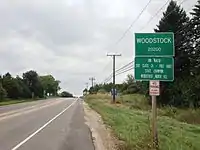
In the 2010 census, Woodstock has a total area of 13.55 square miles (35.09 km2), all land.[39]
Demographics
| Census | Pop. | Note | %± |
|---|---|---|---|
| 1860 | 1,327 | — | |
| 1870 | 1,574 | 18.6% | |
| 1880 | 1,475 | −6.3% | |
| 1890 | 1,683 | 14.1% | |
| 1900 | 2,502 | 48.7% | |
| 1910 | 4,331 | 73.1% | |
| 1920 | 5,523 | 27.5% | |
| 1930 | 5,471 | −0.9% | |
| 1940 | 6,123 | 11.9% | |
| 1950 | 7,192 | 17.5% | |
| 1960 | 8,897 | 23.7% | |
| 1970 | 10,226 | 14.9% | |
| 1980 | 11,725 | 14.7% | |
| 1990 | 14,353 | 22.4% | |
| 2000 | 20,151 | 40.4% | |
| 2010 | 24,770 | 22.9% | |
| 2020 | 25,630 | 3.5% | |
| U.S. Decennial Census[40] 2010[41] 2020[42] | |||
2020 census
| Race / Ethnicity | Pop 2010[41] | Pop 2020[42] | % 2010 | % 2020 |
|---|---|---|---|---|
| White alone (NH) | 17,748 | 16,456 | 70.56% | 64.21% |
| Black or African American alone (NH) | 513 | 737 | 2.07% | 2.88% |
| Native American or Alaska Native alone (NH) | 40 | 33 | 0.16% | 0.13% |
| Asian alone (NH) | 562 | 527 | 2.27% | 2.06% |
| Pacific Islander alone (NH) | 15 | 2 | 0.06% | 0.01% |
| Some Other Race alone (NH) | 16 | 106 | 0.06% | 0.41% |
| Mixed Race/Multi-Racial (NH) | 294 | 860 | 1.19% | 3.36% |
| Hispanic or Latino (any race) | 5,852 | 6,909 | 23.63% | 26.96% |
| Total | 24,770 | 25,630 | 100.00% | 100.00% |
2000 Census
In the 2000 census,[43] there were 20,151 people, 7,273 households, and 4,843 families in the city. The population density was 1,891.1 inhabitants per square mile (730.2/km2). There were 7,599 housing units at an average density of 713.1 per square mile (275.3/km2). The racial makeup of the city was 87.48% White, 1.06% African American, 0.23% Native American, 2.01% Asian, 7.69% from other races, and 1.52% from two or more races. Hispanic or Latino of any race were 19.01% of the population.
There were 7,273 households, out of which 37.5% had children under the age of 18 living with them, 52.7% were married couples living together, 9.7% had a female householder with no husband present, and 33.4% were non-families. 27.3% of all households were made up of individuals, and 9.2% had someone living alone who was 65 years of age or older. The average household size was 2.68 and the average family size was 3.30.
In the city, the population was spread out, with 27.9% under the age of 18, 10.2% from 18 to 24, 33.2% from 25 to 44, 18.9% from 45 to 64, and 9.8% who were 65 years of age or older. The median age was 32 years. For every 100 females, there were 100.8 males. For every 100 females age 18 and over, there were 98.5 males.
The median income for a household in the city was $47,871, and the median income for a family was $54,408. Males had a median income of $40,137 versus $27,264 for females. The per capita income for the city was $23,210. About 5.3% of families and 7.2% of the population were below the poverty line, including 8.0% of those under age 18 and 3.0% of those age 65 or over.
References
- "2020 U.S. Gazetteer Files". United States Census Bureau. Retrieved March 15, 2022.
- "Find a County". National Association of Counties. Archived from the original on May 31, 2011. Retrieved June 7, 2011.
- "Woodstock city, Illinois". United States Census Bureau. Retrieved April 15, 2022.
- "Midwest Region travel sites- Woodstock IL -2007". Preservation Nation. Archived from the original on January 20, 2009. Retrieved December 10, 2008.
- "Woodstock, IL". Encyclopedia.chicagohistory.org. Retrieved March 31, 2016.
- Debs, Eugene Victor (January 1, 1908). Debs: His Life, Writings and Speeches: With a Department of Appreciations. C. H. Kerr & Company.
- "Eugene V. Debs - Facts & Summary - HISTORY.com". HISTORY.com. Retrieved February 24, 2017.
- Baker, Nancy L. (2006). Woodstock, by Nancy Baker. Arcadia. ISBN 9780738540801.
- "Emerson Lofts - Models | Our luxurious one and two bedroom lofts feature a perfect blend of historical and contemporary style". www.emersonlofts.com. Retrieved November 22, 2016.
- "Orson Welles Biography - Biography.com". Archived from the original on October 12, 2010. Retrieved October 9, 2010.
- "Close Up: Orson Welles, part 1". Interview by Bernard Braden, Canadian Broadcasting Corporation, February 25, 1960 (22:58–23:12). Retrieved September 26, 2014.
- "Orson Welles 1934 Todd Theatre Festival 80th Anniversary". Woodstock Opera House. Archived from the original on August 12, 2014. Retrieved September 26, 2014.
- "Orson Welles Stage dedicated at Woodstock Opera House". Wellesnet. February 10, 2013. Retrieved September 26, 2014.
- Tarbox, Todd, Orson Welles and Roger Hill: A Friendship in Three Acts. Albany, Georgia: BearManor Media, 2013, ISBN 1-59393-260-X.
- "Todd School for Boys 1848–1954, Woodstock, Illinois" (PDF). Woodstock Public Library. Archived from the original (PDF) on September 5, 2014. Retrieved September 26, 2014.
- "Orson Welles is Dead at 70; Innovator of Film and Stage". The New York Times. Retrieved November 22, 2016.
- Channick, Robert (September 5, 2008). "In Woodstock, historic dorm for boys school attended by Orson Welles faces demolition". Chicago Tribune. Retrieved April 28, 2014.
- "About Hearthstone Communities". Hearthstone Communities. Retrieved April 28, 2014.
- "Groundhog Day (1993)". IMDb. Retrieved March 31, 2016.
- "We visit the town that brought Groundhog Day to life · Pop Pilgrims · The A.V. Club". Avclub.com. July 25, 2013. Retrieved March 31, 2016.
- "Every Day is Groundhog Day in Woodstock, IL!". Woodstockgroundhog.org. Archived from the original on January 12, 2012. Retrieved March 31, 2016.
- Wayland, Michael (February 3, 2020). "How Jeep landed Bill Murray for its 'Groundhog Day' Super Bowl ad". CNBC. Retrieved April 8, 2021.
- "Bored Silly (2000)". IMDb.com. Retrieved May 2, 2018.
- "WOODSTOCK BACK ON SILVER SCREEN FOR HBO PILOT". Retrieved September 7, 2018.
- "Doodle Valley" (JPG). Retrieved September 24, 2023.
- "Shots for Toyota commercial and 'Lightyears' filmed in Woodstock Square". October 2021.
- "About the Woodstock Independent Newspaper". Archived from the original on October 17, 2010. Retrieved October 9, 2010.
- ""The Torch" - A Special Publication of the Woodstock Independent". Archived from the original on October 17, 2010. Retrieved October 9, 2010.
- "Potts & Pans, Inc. NFP". Pottsandpans.org. Retrieved November 21, 2013.
- "District 200 - History of District 200". Archived from the original on August 21, 2009. Retrieved March 6, 2010.
- "District 200 - Schools". Archived from the original on February 21, 2009. Retrieved March 6, 2010.
- "Retreat & Ecology Campus: Loyola University Chicago". Loyola University Chicago - Retreat & Ecology Campus. Retrieved November 22, 2016.
- "Comprehensive Annual Financial Report" (PDF). Woodstockil.gov. p. 143. Retrieved March 9, 2019.
- "Metra UPNW Current Schedule" (PDF). www.metrarail.com. January 29, 2012. Retrieved February 24, 2017.
- Division of Strategic Capital Planning, Metra (Spring 2014). "Metra Commuter Rail System Station Statistics - 2014" (PDF). www.metrarail.com.
- Division of Strategic Capital Planning, Metra (Spring 2014). "Metra Commuter Rail System Station Statistics - 2014" (PDF). www.metrarail.com.
- "Pace Bus - Route 807- Woodstock-McHenry". www.pacebus.com. Retrieved February 24, 2017.
- "Illini Legends, Lists & Lore: Lynn Stewart | News-Gazette.com". Illinihq.com. October 4, 2009. Retrieved March 31, 2016.
- "G001 - Geographic Identifiers - 2010 Census Summary File 1". United States Census Bureau. Archived from the original on February 13, 2020. Retrieved December 27, 2015.
- "Decennial Census of Population and Housing by Decades". US Census Bureau.
- "P2 HISPANIC OR LATINO, AND NOT HISPANIC OR LATINO BY RACE – 2010: DEC Redistricting Data (PL 94-171) – Woodstock city, Illinois". United States Census Bureau.
- "P2 HISPANIC OR LATINO, AND NOT HISPANIC OR LATINO BY RACE – 2020: DEC Redistricting Data (PL 94-171) – Woodstock city, Illinois". United States Census Bureau.
- "U.S. Census website". United States Census Bureau. Retrieved January 31, 2008.
